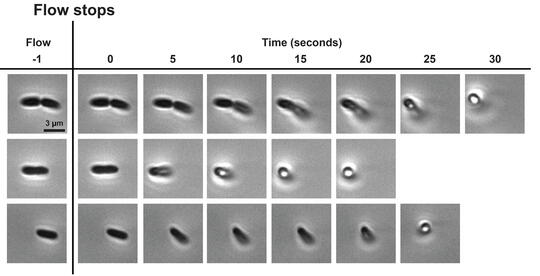
Host tissues and medical devices are ideal surfaces for bacterial pathogens to colonize and infect. Fluid flow is thought to flush bacteria off these surfaces, but University of Illinois researchers have found that some bacteria can strengthen their adhesion to the surface when flow is applied.
In the Sanfilippo lab, researchers study bacteria in fluid flow by utilizing interdisciplinary approaches from biology, chemistry, physics, and engineering. Human pathogens like Pseudomonas aeruginosa adhere well to surfaces in flow-rich parts of the body such as the bloodstream, lungs, and urinary tract.
“Despite the medical importance of this topic, how bacteria attach to surfaces in flow remains unclear,” said Joe Sanfilippo, a professor of biochemistry and principal investigator of the new study. In the article, “Shear force enhances adhesion of Pseudomonas aeruginosa by counteracting pilus-driven surface departure,” published in PNAS, the authors discover how biological and physical factors influence how bacterial cells stick to a surface in high flow regimes.
Shear force counter-intuitively promotes bacterial adhesion
In this study, the researchers used microfluidic devices to test how the human pathogen Pseudomonas aeruginosa responds to shear force.
“The forces that we used in our experiments closely mimic the shear forces of the urinary tract or blood vessels,” Sanfilippo said. Bacteria often stick to medical devices like urinary catheters, causing frequent infections in people with such devices.
“We noticed that as we increased shear force, cells stayed attached for longer,” added Jessica Palalay, Biochemistry PhD candidate and first author of the published article.
“It was quite a shock when we realized that we could see cells changing their orientation and it was reversible. When I turned on flow, I saw cells tip over horizontally. Oppositely, when I turned off the flow, cells stood up and became vertical again,” she said.
However, Palalay’s results brought another character into the playground: the dynamic bacterial appendage known as the type IV pilus.

Paradigm-shift: pili also promote bacterial surface departure
Type IV pili extend from bacterial cells like Pseudomonas aeruginosa and are thought to help cells adhere to the surface.
“Pili can contribute to multiple contact points on the surface. It is a way for a cell to contact a surface,” Palalay said. It was thought that if you removed them, the cell won’t stick to the surface very well. However, the researchers were surprised to find that when they genetically remove the pili, cells stick to the surface better.
“We have evidence that pilus retraction tilts bacterial cells up, ultimately leading to surface departure. We are excited as these results shift the paradigm in the field that pili are there to promote adhesion,” Sanfilippo said.
In the future, the Sanfilippo lab plans to continue its investigation of the biophysical mechanisms that cells use to stick to surfaces in flow. Specifically, researchers plan to study how other surface appendages like the flagellum affect attachment in flow-rich environments.
“By understanding how single cells behave in flow-rich environments, we are providing new perspective into how bacteria interact with the physical aspects of the human host during infection,” Palalay said.
This work is supported by the National Institutes of Health.

